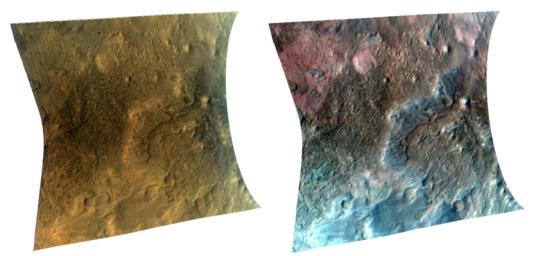
|
Olivine in the Southern Isidis Basin
- Click the image above for a larger view
- Full-Res JPEG (1363 x 651) (120.7 kB)
- Full-Res TIFF (1363 x 651) (2.7 MB)
Caption:
The Compact Reconnaissance Imaging Spectrometer for Mars (CRISM) took this observation of the transition region between Libya Montes and the Isidis Basin on Mars at 17:16 UTC (12:16 p.m. EST) on January 2, 2007, near 3.6 degrees north latitude, 84.1 degrees east longitude. The image was taken in 544 colors covering 0.36-3.92 micrometers, and shows features as small as 18 meters (60 feet) across. The image is about 11 kilometers (7 miles) wide at its narrowest point.
The Isidis Basin resulted from of a gigantic impact on the surface of Mars early in the planet's history. The southern rim, where this target is located, is a region of complex geology and part of the planetary dichotomy boundary that separates the older southern highlands from the lower, younger northern plains. The image on the left was constructed from three visible wavelengths (RGB: 0.71, 0.60, 0.53 microns) and is a close approximation of how the surface would appear to the human eye. The image on the right was constructed from three infrared wavelengths (RGB: 2.49, 1.52, 1.08 microns) chosen to highlight variations in the mineralogy of the area. Of interest is that features in this image not only differ in color, but also in texture and morphology. The gray areas absorb similarly at all wavelengths used in this image, but display absorptions at other wavelengths related to the iron- and magesium-rich mineral pyroxene. The reddest areas absorb strongly at the wavelengths used for green and blue, which is attributable to another iron- and magesium-rich mineral, olivine. The brownish areas show subdued mineral absorptions and could represent some type of mixture between the other two materials. The presence of the mineral olivine is particularly interesting because olivine easily weathers to other minerals; thus, its presence indicates either the lack of weathering in this region or relatively recent exposure.
Background Info:
CRISM's mission: Find the spectral fingerprints of aqueous and hydrothermal deposits and map the geology, composition and stratigraphy of surface features. The instrument will also watch the seasonal variations in Martian dust and ice aerosols, and water content in surface materials -- leading to new understanding of the climate.
The Compact Reconnaissance Imaging Spectrometer for Mars (CRISM) is one of six science instruments on NASA's Mars Reconnaissance Orbiter. Led by The Johns Hopkins University Applied Physics Laboratory, the CRISM team includes expertise from universities, government agencies and small businesses in the United States and abroad.
Cataloging Keywords:
| Name | Value | Additional Values |
|---|---|---|
| Target | Mars | |
| System | ||
| Target Type | Planet | |
| Mission | Mars Reconnaissance Orbiter (MRO) | |
| Instrument Host | Mars Reconnaissance Orbiter | |
| Host Type | Orbiter | |
| Instrument | Compact Reconnaissance Imaging Spectrometer for Mars (CRISM) | |
| Detector | ||
| Extra Keywords | Color, Dust, Impact, Infrared, Map, Mountain, Thermal, Water | |
| Acquisition Date | ||
| Release Date | 2007-02-23 | |
| Date in Caption | 2007-01-02 | |
| Image Credit | NASA/JPL/JHUAPL/Brown University | |
| Source | photojournal.jpl.nasa.gov/catalog/PIA09348 | |
| Identifier | PIA09348 | |
